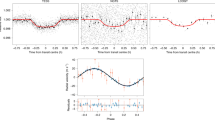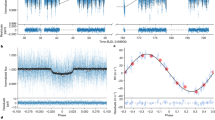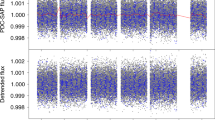Abstract
Recent discoveries of objects orbiting beyond Neptune1,2,3,4,5 have emphasized that our understanding of the distribution and dynamics of material in the outer Solar System is very incomplete. This trans-neptunian population—known as the Kuiper belt—is thought to act as a relatively stable reservoir of objects that could become short-period comets6,7,8,9, although there may be other regions of stability in the outer Solar System that could also supply such comets. Here I use numerical simulations to identify one such long-lived region between the orbits of Uranus and Neptune. I show that in the region 24–27AUfrom the Sun, about 0.3 per cent of an initial population of small bodies moving on low-eccentricity, low-inclination orbits could survive for the age of the Solar System. The actual existence of this hypothetical belt is not precluded by currently available observational limits, and there could be as much as ∼5 × 10−4 Earth masses of material populating this region—comparable to the mass of the asteroid belt between Mars and Jupiter.
This is a preview of subscription content, access via your institution
Access options
Subscribe to this journal
Receive 51 print issues and online access
$199.00 per year
only $3.90 per issue
Buy this article
- Purchase on Springer Link
- Instant access to full article PDF
Prices may be subject to local taxes which are calculated during checkout



Similar content being viewed by others
References
Jewitt, D. & Luu, J. X. Discovery of the candidate Kuiper belt object 1992QB1. Nature 362, 730–732 (1993).
Irwin, M., Tremaine, S. & Zytkow, A. N. Asearch for slow-moving objects and the luminosity function of the Kuiper belt. Astron. J. 110, 3082–3092 (1995).
Williams, I. P., O'Ceallaigh, D. P., Fitzsimmons, A. & Marsden, B. G. The slow-moving objects 1993SB and 1993SC. Icarus 116, 180–185 (1995).
Jewitt, D., Luu, J. & Chen, J. The Mauna Kea-Cerro-Tololo (MKCT) Kuiper belt and Centaur survey. Astron. J. 112, 1225–1238 (1996).
Cochran, A. L., Levison, H. F., Stern, S. A. & Duncan, M. J. The discovery of Halley-sized Kuiper belt objects using the Hubble Space Telescope. Astrophys. J. 455, 342–346 (1995).
Duncan, M., Quinn, T. & Tremaine, S. Astrophys. J. 328, L69–L73 (1988).
Holman, M. J. & Wisdom, J. Dynamical stability in the outer solar system and the delivery of short period comets. Astron. J. 105, 1987–1999 (1993).
Levison, H. F. & Duncan, M. J. The gravitational sculpting of the Kuiper belt. Astrophys. J. 406, L35–L38 (1993).
Levison, H. F. & Duncan, M. J. From the Kuiper belt to Jupiter-family comets: the spatial distribution of ecliptic comets. Icarus(in the press).
Gladman, B. & Duncan, M. J. On the fates of minor bodies in the outer solar system. Astron. J. 100, 1680–1693 (1990).
Holman, M. in Proc. 27th Symp. on Celestial Mechanics(eds Kinoshita, H. & Nakai, H.) 116–136 (Natl Astron. Observatory of Japan, Tokyo, (1995)).
Roy, A. E. Orbital Motion(Hilger, Bristol, (1988)).
Levison, H. F. & Duncan, M. J. The long-term dynamical behavior of short-period comets. Icarus 108, 18–36 (1994).
Dones, L., Levison, H. F. & Duncan, M. Completing the Inventory of the Solar System(eds Rettig, T. W. & Hahn, J. M.) 233–244 (ASP Conf. Proc., Astron. Soc. Pacif., San Francisco, (1996)).
Stern, S. A. Collision timescales in the Kuiper disk: model estimates and their implications. Astron. J. 110, 856–868 (1995).
Davis, D. R. & Farinella, P. Collisional evolution of Edgeworth-Kuiper belt objects. Icarus 125, 50–60 (1997).
Fernandez, J. A. & Ip, W. H. Some dynamical aspects of the accretion of Uranus and Neptune: the exchange of orbital angular momentum with planetesimals. Icarus 58, 109–120 (1984).
Malhotra, R. The origin of Pluto's peculiar orbit. Nature 365, 819–821 (1993).
Malhotra, R. The origin of Pluto's orbit: implications for the solar system beyond Neptune. Astron J. 110, 420–429 (1995).
Morbidelli, A. & Valsecchi, G. B. Neptune scattered planetesimals could have sculpted the primordial Edgeworth-Kuiper belt. Icarus(in the press).
Duncan, M. J., Levison, H. F. & Budd, S. M. The dynamical structure of the Kuiper belt. Astron. J. 110, 3073–3081 (1996).
Tremaine, S. in Baryonic Dark Matter(eds Lynden-Bell, D. & Gilmore, G.) 37–65 (Kluwer, Boston, (1990).
Kowal, C. T. Asolar system survey. Icarus 77, 118–123 (1989).
Weissman, P. R. & Levison, H. F. The size distribution of cometary nuclei. Lunar Planet. Sci. 27, 1409 (1996).
Kresak, L. Mass content and mass distribution of the asteroid system. Bull. Astron. Inst. Czech. 28, 65–82 (1977).
Morrison, D. Asteroid sizes and albedos. Icarus 31, 185–220 (1977).
Acknowledgements
I thank N. Murray and S. Tremaine for discussions, S. Dermott and H. Levison for reviews of the manuscript, and J. Wisdom for computer time for the simulations.
Author information
Authors and Affiliations
Corresponding author
Rights and permissions
About this article
Cite this article
Holman, M. A possible long-lived belt of objects between Uranus and Neptune. Nature 387, 785–788 (1997). https://doi.org/10.1038/42890
Received:
Accepted:
Issue Date:
DOI: https://doi.org/10.1038/42890
This article is cited by
-
Advances in exoplanet science from Kepler
Nature (2014)
-
High order explicit Runge–Kutta Nyström pairs
Numerical Algorithms (2013)
-
Possible long-lived asteroid belts in the inner Solar System
Nature (1999)
Comments
By submitting a comment you agree to abide by our Terms and Community Guidelines. If you find something abusive or that does not comply with our terms or guidelines please flag it as inappropriate.



